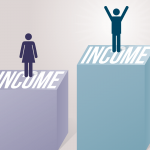Gender Parity Will Dramatically Improve the Economy
April 20, 2016
 As we’ve written before, promoting gender equality plays a vital role in retaining top talent, boosting bottom line profits, attracting consumers to your brand, and embodying a conscientious, fully human work culture. It isn’t just good for business, however. As McKinsey Global Institute’s new study demonstrates, gender parity will dramatically improve the economy.
As we’ve written before, promoting gender equality plays a vital role in retaining top talent, boosting bottom line profits, attracting consumers to your brand, and embodying a conscientious, fully human work culture. It isn’t just good for business, however. As McKinsey Global Institute’s new study demonstrates, gender parity will dramatically improve the economy.
Equal Pay Day
In the United States, April doesn’t just bring showers to grow May flowers. It also brings the IRS. However, this month marks another event that often gets blurred in the frenzy of the annual tax deadline. Even the media turns the scramble of last-minute filers into a spectacle. So as millions of Americans focus their attention on audits and complicated government forms, they forget the undeniable (and equally economic) significance of Equal Pay Day.
This symbolic campaign was originated by the National Committee on Pay Equity (NCPE) in 1996 to raise public awareness of the wage gap between men and women. And there’s a good reason. Every April, women’s earnings catch up to men’s from the last year. What does that mean? On average, women must work an extra 103 days to earn the same amount of money as their male colleagues.
Consider the case of the U.S. Women’s Soccer team, which scored a resounding victory over Japan in July’s World Cup Championship. Immediately after the team’s triumph, President Obama said, “This team taught all of America’s children that ‘playing like a girl’ means you’re a badass.” Sadly, these champions earn only 40 percent of the compensation that members of the men’s soccer team make.
It’s no coincidence that the team filed a complaint with the Equal Employment Opportunity Commission (EEOC) at the beginning of the month — just in time for Equal Pay Day. Goaltender Hope Solo, one of the players who signed the complaint, told the New York Times: “The numbers speak for themselves. We are the best in the world, have three World Cup championships, four Olympic championships.” She added that male players “get paid more to just show up than we get paid to win major championships.”
After examining the figures, New York Times reporters broke down the actual inequality: “A men’s player, for example, receives $ 5,000 for a loss in a friendly match but as much as $ 17,625 for a win against a top opponent. A women’s player receives $ 1,350 for a similar match, but only if the United States wins; women’s players receive no bonuses for losses or ties.”
There are deeper concerns beyond wage inequalities. Census data show that the most predominant jobs for women involve lower-paying positions such as food servers, cashiers or secretaries. Meanwhile, men outnumber women in lucrative fields: programmers, lawyers, physicians and others. When women do break down the barriers and enter those ranks, they find substantially less pay for the same work. As a result, the World Economic Forum drew the dire conclusion that, in the absence of change, it would take the world 118 years to finally close the economic gender divide.
The Economic Imperative of Gender Parity
Women make up more than half the talent pool. Beyond that, they’re responsible for over 80 percent of the buying decisions in this country. That’s an overwhelming amount of consumer power. By failing to promote women as equal leaders in the workplace, businesses effectively stifle their own profit potential. The data revealed by McKinsey show that the issue is much more sweeping: “Every state and city in the United States has the opportunity to further gender parity, which could add $ 4.3 trillion to the country’s economy in 2025.”
In other words, over the next decade every city and state can add at least five percent to their Gross Domestic Product (GDP) by championing the economic opportunities of women. The report also finds that half of U.S. states have the potential to add more than 10 percent, and the country’s 50 largest cities can increase GDP by six to 13 percent.
Echoing the research of the World Economic Forum, McKinsey acknowledges that realizing these goals by 2025 remains an unlikely scenario; too many barriers persist that hinder women from fully participating in the labor market. However, McKinsey proposes an attainable best-in-case model. If each U.S. state matches the state exhibiting the fastest rate of gender parity growth, we can add “$ 2.1 trillion of incremental GDP” by 2025. That’s 10 percent higher than running with the status quo.
To examine the impressive benefits on a smaller scale, a state like Illinois could generate an increase in its GDP of nearly $ 60 billion — a jump of seven percent for simply narrowing the gender income gap.
How Can We Help Achieve Gender Parity?
As staffing professionals, we have an obligation and the expertise to help the nation build a truly egalitarian workforce — where skills, not gender, determine compensation.
- We can help locate flexible roles and work cultures, where travel is minimized, schedules are fluid and options for remote work exist. Even with the aggressive push for innovation and output, more employers are developing family-friendly options. As experts in sourcing and recruiting, we can become ideal advocates for women professionals seeking the appropriate balance between personal and career responsibilities.
- We can help to design accelerators and networking programs for leadership and managerial opportunities.
- We can include financial and skills training for victims of abuse or women re-entering the workforce after prolonged absences.
- By matching skills to needs, without bias, we can work to equalize the sectors where women are recruited. While they dominate growth areas such as education and health care, they remain underrepresented in higher paying roles like IT and manufacturing.
- By adopting a more consultative approach to employers, we can help businesses create a team of diversity champions, across all employment levels of the enterprise, to advise on fair and inclusive processes for retention, recognition, skills coaching, effective management techniques, bias prevention education, performance and compensation reviews, and more.
- We can set inclusiveness goals and hold managers accountable.
- We should strive to develop and implement merit-based hiring strategies that emphasize ideal cultural fits — not familiarity fits — aligned to the organization’s overarching strategies and objectives. These strategies focus on filling key positions with the best people across diversity groups, eliminating perceptions that people are hired to fill quotas.
- Successfully recruiting women must involve a serious focus on compensation, skills development and advancement opportunities.
- We can lobby governments to consider ways to make paid parental leave and improved child care a reality for men and women alike. Women perform more than twice as much unpaid work as men. And although men now want to increase their time at home, many feel they can’t without sacrificing the household income.
- We can help facilitate cross-sector collaboration between governments, businesses and nonprofit organizations.
Equal Pay Creates a Larger, More Vibrant Economy
Top performing companies have long realized the benefits of diversity as a profit center, employment brand, business culture and innovation machine. Though women today have attained historic highs in terms of career progression and leadership opportunities, there are still significant pay gaps and prejudices. And the situation defies reason.
- Full-time working women, despite their greater likelihood of completing a university education, earn 18 percent less than men.
- Women are more likely than men to invest larger portions of their incomes in the education and health of their children, ensuring the development of stronger future talent.
- Gender-balanced workplaces generate higher levels of efficiency savings, employee engagement, productivity, financial performance, and better meet the needs of diverse suppliers and customers.
- Companies that actively promote women outperform their competitors, with overall profits 34 percent higher.
Leading the charge for gender parity doesn’t end with a healthier bottom line — it ends with a more productive, fulfilling and economically powerful nation for this generation and the next.
Photo courtesy of iStock
Business & Finance Articles on Business 2 Community
(20)














